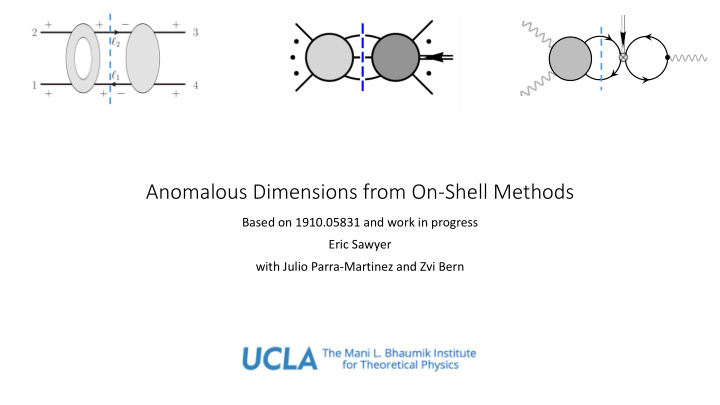



Anomalous Dimensions from On-Shell Methods Based on 1910.05831 and work in progress Eric Sawyer with Julio Parra-Martinez and Zvi Bern
Importance of Renormalization Many major questions involving the UV behavior of field theories UV divergence in N=8 SUGRA (Bern et al. 1201.5366; 1804.09311) Renormalization group flow of higher dimension operators (eg. Alonso, Jenkins, Manohar, Trott 1312.2014) Traditional ways of calculating: Calculate entire amplitude, extract UV dependence (e.g. Brandhuber, Kostacinska, Penante, Travaglinia 1804.05703) Off shell methods
Borrowing Ideas used in Gravity Two loop UV 1/ ε pole is affected by evanescent effects in Einstein gravity Renormalization scale dependence captured by cuts in kinematic variables vs. Renormalization scale dependence determined through on shell unitarity cuts (Bern, Cheung, Chi, Davies, Dixon, Nohle 1507.06118; Bern, Chi, Dixon, Edison 1701.02422)
Form Factors and Renormalization From Caron-Huot and Wilhelm (1607.06448) Unitarity: Analyticity: “the dilatation operator is minus the phase of the S-matrix, divided by π”
Form Factors and Renormalization Unitarity: Analyticity: Renormalization scale related to dilatation operator: (Caron-Huot and Wilhelm 1607.06448)
Form Factors and Renormalization: Perturbative Expansion One loop anomalous dimensions: (Caron-Huot and Wilhelm 1607.06448)
Form Factors and Renormalization: Perturbative Expansion Minimal First chance for operator mixing form factors (Caron-Huot and Wilhelm 1607.06448)
Standard Model Effective Field Theory SM EFT: more systematic way to explore physics beyond the Standard Model than model building No need to worry about details of high-energy completion SM Λ Operators built out of Standard Model fields Mixing of operators can produce variety of effects at LHC scale from a single operator at scale Λ { } ~TeV
Non-Renormalization Unexpected zeros in anomalous dimension matrix (Alonso, Jenkins, Manohar, Trott 1312.2014) F 3 φ 2 F 2 F 3 φ 2 F 2
Non-Renormalization Unexpected zeros in anomalous dimension matrix (Alonso, Jenkins, Manohar, Trott 1312.2014) Explained using helicity selection rules (Cheung and Shen 1505.01844) (from Cheung and Shen 1505.01844 )
New Non-Renormalization Theorem 1. : number of field insertions in
New Non-Renormalization Theorem 1. : number of field insertions in 2.
Longer operators often cannot renormalize shorter operators, even when diagrams are available Minimal form factor q Required for nonzero result: • ≥2 external legs on the left • No scaleless bubbles on the right : total loop number : loops in form factor : number of field insertions in
Longer operators often cannot renormalize shorter operators, even when diagrams are available q : total loop number : loops in form factor
First order of renormalization can often be calculated using only 4-d methods Requires d-dimensional information
Two-loop Examples Renormalization of φ 2 F 2 by φ 6 Renormalization of F 3 by ψ 4 q q Scaleless bubble evaluates to zero
Results for Dimension 5-7 Operators d=5 Zero by helicity rules of Cheung and Shen d=6 Overlap of zeros of Cheung and Shen and our work New anomalous dimension zeros (Bern, Parra-Martinez, ES 1910.05831)
Results for Dimension 5-7 Operators d=7 Zero by helicity rules of Cheung and Shen Overlap of zeros of Cheung and Shen and our work New anomalous dimension zeros (Bern, Parra-Martinez, ES 1910.05831)
Non-zero Entries Require 1-loop Amplitudes 1. Write down tree amplitudes 2. Construct cuts between trees 3. Integrate and merge cuts d-dimensional 1-loop amplitudes 4. Construct two-loop cuts (2) 5. Extract 2-loop anomalous dimension
The Dimension 6 Operators
Results All four point SM EFT amplitudes with dimension 6 operators Verifying the anomalous dimension calculations using on-shell techniques Non-zero rational terms everywhere 2-loop anomalous dimensions likely generally non-zero (Bern, Parra-Martinez, ES 2001.XXXXX)
Two-loop Anomalous Dimensions We can now calculate any 2-loop anomalous D 2 φ 4 ψ 4 dimension of the SM EFT Simple cases: calculation of only one type of cut required φ 2 F 2 F 3 For a general entry in the matrix, IR dependence must be accounted for φ 2 F 2 ψ 4
Summary and Outlook On-shell methods can be used to efficiently calculate anomalous dimensions Unitarity cuts in kinematic variables yield renormalization scale dependence On shell methods can be used in gravity as well, and double copy should help Example: F 3 double copies to R 3
Thanks!
Recommend
More recommend